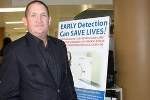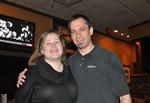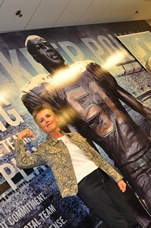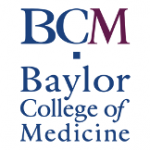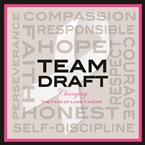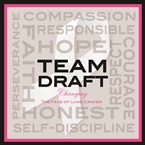 A Young Mother’s Fight with Lung Cancer: a Story of Hope
A Young Mother’s Fight with Lung Cancer: a Story of Hope
By Aisha Avery
Meet Natalie DiMarco, a 34-year-old daughter, wife, and mother of two. She was born in San Francisco and raised in Tucson, Arizona. Her family returned to the Bay Area when she was a teenager. She attended Palo Alto High School where she played soccer and softball.
Before DiMarco learned she had lung cancer, she actively attended sporting events with her husband, Jim. She had also taken a break from teaching at an elementary school in San Jose. Her focus had become raising her two daughters.
“Do you want me to give you my whole story?” She asked at the beginning of our interview.
When meeting someone for the first time, typically you would expect them to tell you their personal history. When you meet a lung cancer survivor, their story becomes about their battle with the disease.
“I was diagnosed in March 2010, the same week my second daughter turned one and my other daughter was two-and-a-half,” DiMarco said.
What was initially thought to be asthma and a bad cough, turned out to be Stage IV lung cancer. “It took six months for me to get diagnosed,” she said. The cancer was diffused throughout her entire left lung.
She explained that she set out to tackle the disease immediately and traveled to speak with cancer centers across the country to learn the extent of what she was dealing with. The cancer had also spread to her lymph nodes which prevented her from being a candidate for pre-invasive surgery.
Her treatment strategy has been a collaborative effort of the doctors she has met with and is led by her primary oncologist, Dr. Heather Wakelee at Stanford Cancer Center. “We don’t just talk about what my treatment is now,” said DiMarco. “We’re always looking ahead of the situation.”
DiMarco is often asked if she was a smoker. Her answer is always: “No.”
“Unfortunately, lung cancer is a disease that can happen to people at all different ages and people with and without a history of smoking,” Dr. Wakelee explained.
“For people like Natalie who are young and don’t have a smoking history, it’s just as hard of an illness for everybody else so they have to deal with a lot of questions which is even harder in some ways.”
DiMarco is a few months away from her three year anniversary with lung cancer, but she is determined to beat it. She dreams of regaining full strength and having the stamina to get back to into the classroom as a helper. She said her daughters are her primary sources of hope.
“I encourage all of my patients to live with hope,” said Dr. Wakelee.
“By focusing on her belief that she is going to be okay and that she is going to be there to be the mom for her kids, Natalie’s been able to face this head on.”
DiMarco is using her story to increase awareness because she wants to help others. “It could be anyone,” she said. “People need to know the signs.”
Which is why attending and being honored at Candlestick Park in November when the San Francisco 49ers hosted the Chicago Bears was so special.
“Being able to attend that game with my husband was very important to me,” she shared. “Having the stamina to stand most of the game was a great accomplishment.”
Her attendance was part of a campaign led by Chris Draft, co-founder of Team Draft, to celebrate survivorship that took place at stadiums across the country. Draft said, “As a former 49er and Stanford Alum, I am so thankful for the 49ers support of Team Draft’s National Campaign to Change the Face of Lung Cancer in the Bay Area.”
DiMarco was one of 14 lung cancer survivors to attend an NFL game this November for National Lung Cancer Awareness month.
After 43 cycles of chemotherapy, the cancer that was once diffused throughout her left lung has now reduced to one spot. Considering that lung cancer survival rates are low and she was diagnosed after her cancer began to spread to her lymph nodes, her progress should indeed be celebrated.
She was able to go onto the field and even ran into an old classmate from Palo Alto, the 49ers’ defensive assistant and quality control coach Peter Hansen, who used to sit behind her in science class.
“When she told me, it took my breath away,” Hansen said. It was their first time seeing each other
since shortly after high school.
Like most who come in contact with DiMarco, Hansen was encouraged by her positive energy and
outlook. He said he felt positive about the direction she said her treatment was going.
DiMarco attributes her improvement to her treatment, a more positive attitude, a healthier lifestyle,
and the traditional Chinese medicine such as acupuncture, organ massage, and acupressure that she
began receiving from Dr. Angela Wu in San Francisco after she was diagnosed.
Dr. Wu has helped DiMarco focus on positive thinking. “We don’t talk about the fact that there is
cancer involved,” she explained. “We just focus on me getting healthier every day.”
Now that her cancer has been reduced down to one spot, DiMarco has been able to take a holiday
from chemotherapy after receiving a round of targeted radiation therapy last month. She is scheduled
for a scan in February to monitor her progress.
She has great hope for the lung cancer research efforts underway. “I know one day there will be a pill
designed for my tumor,” she said. “If it ever comes back, I’ll get to take it.”
DiMarco is encouraged by the 49ers’ support and Team Draft’s efforts. As a passionate advocate for
the cause, she is determined to spread her hope and play a role in increasing lung cancer awareness.
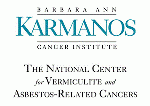 Gerold Bepler, M.D., Ph.D.
Gerold Bepler, M.D., Ph.D.

